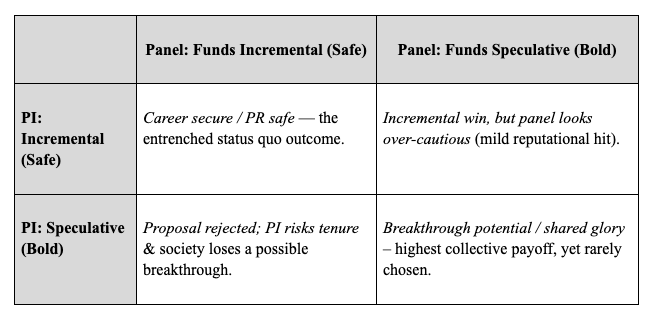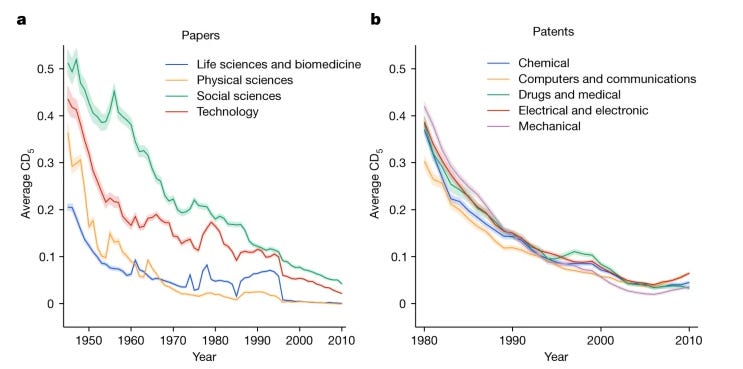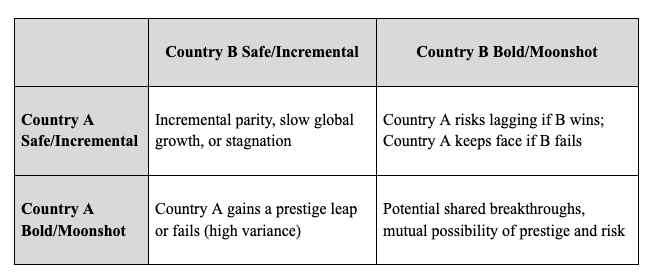Welcome to the Logbook. Consider this first piece the overture, threads to be pulled across future entries.
The lab has a locked drawer.
A select number of graduate students in Professor X’s molecular biology group know it exists, but they rarely speak of it.
Inside are the remnants from a decades-old abandoned project: an attempt to engineer bacteriophages that deliver CRISPR payloads in vivo to extinguish antibiotic-resistant infections. The idea was audacious. After two triaged NIH applications and a hallway warning, Professor X shelved the work. She sharply pivoted to a safer grant topic, won funding, and published paper after paper. Headlines rave about her success.
The drawer remains locked, a quiet monument to rational self-censorship in modern science.
Science has talent and money, but no permission to wander. Even as global research and development (R&D) spending has tripled over the last few decades, truly disruptive discoveries have dried up.
The scientific community has reached a collectively irrational equilibrium where innovation slows because individual actors (researchers, institutions, funders) are optimizing for their own incentives within a flawed system. The result: we invest unprecedented resources in research, only to reward the safest experiments. We hail these headlines, etch them again in different fonts, and the vicious cycle continues.
This is precisely a Nash equilibrium. Many before me1 have dissected what I call Game One, the local game that governs choices in labs and funding agencies. Zoom out to see the whole board, and above it is Game Two, where scientific triumphs are geopolitical trophies, and failure becomes a geopolitical liability. Importantly, Game One flows downstream of Game Two.
Game One – The Local Incentive Loop
Refresher. A Nash equilibrium is a state in which no player can improve their payoff by unilaterally changing strategy. In science, this translates to a local optimum: each actor’s safest move keeps everyone stuck even when a global leap would raise the collective payoff. Co-operate on safe projects and you earn steady rewards; defect alone with a wild idea and you absorb all downside if it fails. Unless many defect simultaneously, the rational choice is to stay cautious.
Why defecting is, rationally, irrational (in the status quo)
A principal investigator (PI) weighs two paths. If she proposes a speculative therapy and it fails, she may risk losing tenure; if she submits an incremental extension of her previous R01, her publication rate remains on track. Review panels feel a parallel pressure: fund a dud, and the failure is public, but even if you reject what later proves revolutionary, no one remembers. Both actors default to safe moves.

Who’s playing and why they stay put
Empirical Fingerprints of the Equilibrium
Below are four independent symptom sets that all point in the same direction: incentives have shifted from maximizing innovation to maximizing safety.
Disruption in Free-Fall
The bluntest datapoint comes from a 2023 Nature study that tracks a CD-index of how much a paper or patent displaces prior work. The median disruptiveness of scientific articles has decreased by approximately 91% since the 1945-1990 golden era, despite a twelve-fold increase in publication volume. In other words, we are generating more knowledge units than ever, but far fewer of them change anyone’s mind.
Citation & Prestige Loops
Because promotion committees and search engines fixate on citation tallies, researchers slice discoveries into multiple “minimal publishable units.” The H-index ultimately privileges quantity over conceptual leaps. 1% of NIH PIs capture 11% of the institute’s grant dollars, and dollar concentration translates into thematic convergence.
Peer-Review Risk Aversion
Donald Braben’s interviews with former panel members reveal that panels systematically down-weight unproven, novel ideas, because failure triggers audits, while success merely blends into the applicant’s CV. You should never back a proposal you can be blamed for later.
A Mirror in Creative Industries
Science is not alone. Following Nintendo’s 1990s dominance, Japan’s major game publishers shifted their focus toward sequels rather than new productions. By 2015, fewer than one in ten releases from leading developers were new IP. Corporate keiretsu structures punished failures more than they rewarded novelty, because when the safest path to next quarter’s revenue is a remake, originality stalls. There is little incentive to change the game.

Incentive Architecture – How We Got Stuck
Publish-or-Perish & the Tenure Cliff
Assistant professors face an approximately 6-year runway to secure lifetime employment. The optimal strategy is to stack incremental papers with guaranteed citations rather than gamble on a multi-year moonshot that might never land. Expected personal utility beats expected social benefit.
Grant-Panel Loss Aversion
See above. Panels operate under asymmetric scrutiny: a funded failure is documentable waste; an unfunded success is an invisible counter-factual.
False Scarcity & Prestige Signalling
See above. Scarcity converts each funding cycle into a tournament where reviewers seek consensus “sure things.” University rankings compound this: administrators value predictable overhead flows from big, steady grants more than long-shot possibilities.
Metric Capture & Reputation Hedging
Bibliometrics, alt-metrics, and grant-score dashboards create visible leaderboards. This means science is no longer a ‘collaborative’ sport. Once performance is public, actors optimize for what is legible, not what is important.
“If we graded chefs the way we grade PIs, everyone would serve risotto.”
Pierre Azoulay, lecture for Organizing for Innovation (15.374), MIT Sloan School of Management, Cambridge, MA, February 26, 2024.
Layer these all together, and we get the local Nash equilibrium: rational hedging at every node, systemic mediocrity in aggregate.
Enter Game Two
Game One would be damaging enough if it were the only game in play. It isn’t. Hovering above tenure files and grant panels is a geopolitical prestige loop in which governments treat scientific milestones as metrics of national power.
Okay, but rivalry can accelerate bold science, no?
The trouble is that today’s prestige race is calibrated for optics, not exploration or creation. Budgets are written around milestones that can be televised before the next election cycle. In China’s state-lab system, fewer than two percent of projects run without predefined deliverables, and India’s iCET corridor funnels grants almost exclusively to tech already at TRL (Technology Readiness Level) 6 or higher.
Game Two locks Game One in place. Agencies downstream absorb state-level anxiety and quietly shave the variance out of their portfolios and laboratories. Local actors hedge because global actors – many of whom dictate funding and reputation – must prioritize optics.
Why rarely anyone defects
In Game Two, defecting would mean a government funnelling significant resources and investment toward often quietly speculative ideas: projects with no obvious commercial market (yet), no rambunctious talking points (yet), and no promise of a viral press release upon success (yet).
Funding an unproven fusion concept or a new therapeutic platform is geopolitically asymmetrical: success is slow to mature, and in many cases, not immediately commercializable, while failure is immediate and often highly publicized. During the COVID-19 vaccine sprint, political leaders boasted about timelines before Phase III data was available, as appearing first conveyed power, even if the science was not actually there.
Yes, a handful of actors do take calculated risks, but pay close attention to who is generally allowed to take these risks and how they’re insulated. Agencies like America’s DARPA or the China Electronics Technology Group Corporation (CETC) can gamble significantly more than civilian or independent projects because the programs are centralized, classified, and backed by budgets measured in defence-line items rather than peer-reviewed scores. A failed hypersonic prototype disappears, but a successful one becomes a point of national pride. The planetary scientist pitching a small, non-flagship mission has no comparable shield. Their applications land in public grant queues subject to auditor scrutiny and potential headline risk.
At the highest level, R&D funding has become a game of appearances: a contest in which regimes protect their legitimacy by staging or exaggerating technological victories and avoiding public failures. In Beijing, the Made in China 2025 for the Party’s centennial ties specific industrial milestones (such as 3 nm fabs, green-energy patents) to the CCP’s claim of unbroken ascent. Missing a goal would puncture that “forward-only” narrative. In Washington, the CHIPS & Science Act also directs new National Science Foundation (NSF) and Department of Defence (DoD) dollars toward technology readiness levels that can be showcased.

Who’s playing and why they stay put
Empirical Fingerprints of the Equilibrium
Selected case studies, chosen for succinctness.
Budget skew toward “critical technologies” (US)
Only 3% of FY-2022 DoD Research, Department, Test, Evaluation (RDT&E) went to basic research (6.1); 45% was funded for late-stage systems development, a distribution that favours headline-ready prototypes over exploratory science. The NSF is leaning the same way: the CHIPS & Science Act formally instructs the new Technology, Innovation & Partnerships (TIP) directorate to channel funds into ten key priority areas, which steers researchers to mould their work to fit the prestige menu, rather than pursue original curiosity.
Milestone capture (China)
The Ministry of Science & Technology’s National Key R&D Program obliges every sub-project to file annual “assessable indicators”; officials at the 2016 launch press conference noted that schedule slippage beyond a single review cycle can trigger termination, leaving <2 % of projects without strict deliverables. Continuous milestone policing keeps ministries from backing ideas whose payoff curve is uncertain.
Defence-sector insulation vs. civilian exposure
DARPA can pursue hypersonics and mixed-technology integration because 85% of its RDT&E budget is allocated to 6.3–6.5 demonstration and prototyping codes that tolerate classified failure. This means it’s not just budget, but organizational design that bolsters its immunity; they are explicitly meant to absorb classical failures without public reproach. In contrast, universities must compete for the remaining 3% basic-research slice and justify every misstep to auditors and congressional staffers. The asymmetry illustrates why bold civilian ideas die early.
How we got here
Four structural shifts, layered on top of one another since the late Cold War, have turned scientific grand strategy into a scoreboard - this is yet another non-exhaustive list.
Cold-War muscle memory. Politicians learned during the 1958-61 “missile-gap” panic that public appearances of technological supremacy matter more than underlying facts; Sputnik headlines and Kennedy’s subsequent Moon pledge were framed as inevitable wins, not uncertain research gambles.
Twenty-four-hour media. A modern failure travels worldwide within minutes. The faster the blast radius of bad news, the more ministries pre-select projects already partway down the engineering pipeline. Reduce failure, reduce ruckus.
Metrics and league tables. Global university rankings, patent dashboards, and OECD “top-citer” lists make research a points game. Universities shift budgets from exploratory to “rank-visible” outputs once they rise in the tables, reinforcing incrementalism.
Export-control politics. Initiatives such as the U.S.-India iCET and the CHIPS & Science Act channel fresh money to “trusted” supply-chain nodes and TRL checkboxes; curiosity-driven lines in physics or biology that lack immediate strategic framing are squeezed out.
The net result is a second-order Nash equilibrium: the first equilibrium (labs) becomes locked because a higher-level equilibrium (states) avoids visible failure. Attempting a unilateral moonshot risks international ridicule if it fails; boldness becomes rational only in an all-in scenario where everyone sprints, and if failures are culturally discounted. Instead, each actor stays put, institutionalizing risk aversion.
Design Principles for a New Funding Ecology
Scientific slowdown is not a mystery of “ideas getting harder,” but the predictable outcome of two overlapping coordination games that penalize variance in multiple spheres of power.
Below are four starter design principles - some of which are already in circulation - that point in a different direction. While these don’t change the way incentives are structured from the core, they act as small ‘samples’ that I hope to expand on in a future piece - coming soon.
Sandbox Capital. Micro-grants (<$250k) with a two-year privacy window, so early failure is not a public spectacle.2
Weighted Lotteries. After an initial quality screen, allocate funds by chance.3
Belief-Backed Fellowships. Let nominators stake personal or institutional reputation, not endless milestone reports, as the chief accountability mechanism.
Disruption Quotas. Dedicate at least 10 % of every public science budget to proposals in the top novelty decile. See the living experiments.
None of these fixes the political optics problem overnight, but each makes it slightly less irrational for a minister, program manager, or PI to take a swing.
Many thanks to Andrew Hui and James Lin for early feedback.
Many of the ideas sketched here stand on the shoulders of those who have been mapping this territory longer than I have. For a more expansive list of thinkers who underpin the Department’s worldview, see the Appendix. Specifically for this piece, I draw from Michael Nielsen’s The Future of Science and Stuart Buck’s Escaping Science’s Paradox.
These ideas are heavily inspired by the writings of Michael Nielsen and Kanjun Qiu, and Ben Reinhardt for IFP.
See also: https://www.nesta.org.uk/feature/ten-predictions-2019/random-approach-innovation/ and https://aeon.co/ideas/science-funding-is-a-gamble-so-lets-give-out-money-by-lottery






